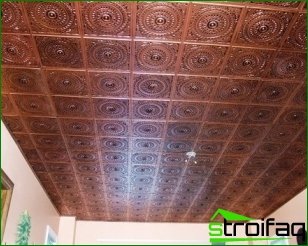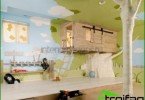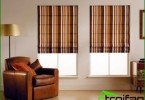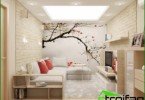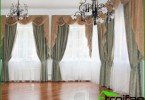The choice of materials for decorating the ceiling in a room is an important occupation. Most often, special plates or wallpapers are used for these purposes. But no one forbids finishing to any other. So, material for the ceiling in the room may become tile, laminate, wood paneling or other coating. Depending on the interior of the room and apartment, you can choose what suits you the most. Today, a huge selection of different types of wallpapers for walls and ceilings is available..
How to choose a wallpaper for the ceiling
If you have already decided that you will wallpaper the ceiling, it is important for you to decide which ones, because there are quite a few varieties of them. If we talk about cullet, they are strong, environmentally friendly and durable. However, flezilin wallpaper will be a good alternative. They perfectly withstand stress, which prevents the occurrence of cracks. Each of the listed types can be painted, so you should not worry about color.
In all seriousness, go to the choice of glue for wallpaper. Indeed, for each type of coating its own type of glue is intended. If you carefully read the instructions and follow them exactly, then the likelihood of peeling off the ceiling will be minimized. Many wallpapers will be a great material for the walls..
Plates – the original material for the ceiling in the room
For pasting the ceiling, you can use plates that consist of foamed polystyrene. Plates can be rectangular (100×16.5 cm) or square (50×50 cm). Their front side may have any relief, but may remain smooth. If necessary, the tile can be painted, but if its surface is laminated, you will not succeed. Light non-laminated material can be used in rooms where the humidity level is low (living rooms, bedrooms).
Laminated tiles can be installed in the kitchen, bathroom or in any other room. You can even decorate the ceiling with your own efforts: it is not difficult to do this, even if you do not have experience in performing this kind of work. From the very beginning it is important to prepare the surface of the ceiling – it should be even, dry and cleaned of any coating. In addition, the surface must be primed and marked for subsequent gluing..
Features of installation and operation of ceiling tiles
To attach the tile to the ceiling, you can use PVA glue or specialized polystyrene glue. By the way, specialized adhesives allow the replacement of individual elements of the material for the floor and ceiling. Experts advise to start gluing the plates from the middle of the ceiling, moving in the direction of the walls. Using a sponge or a soft cloth, glue residue can be removed from the plates. If you decide to paint the non-laminated paint, then use a water-based coloring matter. To qualitatively perform the junction of the ceiling and walls, the corner between them is closed by a holding or cornice. It is better to purchase these parts in the same store as the tiles, and from the same manufacturer.
If we talk about the cost, then the adhesive ceiling is the most affordable type of finish. In addition, it is characterized by ease of care. To wash the laminated tile, it is enough to take a warm soapy solution and a damp sponge, and non-laminated coatings should be wiped with a dry cloth, in addition, they can be vacuumed.
The choice of materials for decorating the ceiling in a room is an important occupation. Most often, special plates or wallpapers are used for these purposes. But no one forbids finishing to any other. So, material for the ceiling in the room may become tile, laminate, wood paneling or other coating. Depending on the interior of the room and apartment, you can choose what suits you the most. Today, a huge selection of different types of wallpapers for walls and ceilings is available..How to choose a wallpaper for the ceiling
If you have already decided that you will wallpaper the ceiling, it is important for you to decide which ones, because there are quite a few varieties of them. If we talk about cullet, they are strong, environmentally friendly and durable. However, flezilin wallpaper will be a good alternative. They perfectly withstand stress, which prevents the occurrence of cracks. Each of the listed types can be painted, so you should not worry about color.
In all seriousness, go to the choice of glue for wallpaper. Indeed, for each type of coating its own type of glue is intended. If you carefully read the instructions and follow them exactly, then the likelihood of peeling off the ceiling will be minimized. Many wallpapers will be a great material for the walls..
Plates – the original material for the ceiling in the room
For pasting the ceiling, you can use plates that consist of foamed polystyrene. Plates can be rectangular (100×16.5 cm) or square (50×50 cm). Their front side may have any relief, but may remain smooth. If necessary, the tile can be painted, but if its surface is laminated, you will not succeed. Light non-laminated material can be used in rooms where the humidity level is low (living rooms, bedrooms).
Laminated tiles can be installed in the kitchen, bathroom or in any other room. You can even decorate the ceiling with your own efforts: it is not difficult to do this, even if you do not have experience in performing this kind of work. From the very beginning it is important to prepare the surface of the ceiling – it should be even, dry and cleaned of any coating. In addition, the surface must be primed and marked for subsequent gluing..
Features of installation and operation of ceiling tiles
To attach the tile to the ceiling, you can use PVA glue or specialized polystyrene glue. By the way, specialized adhesives allow the replacement of individual elements of the material for the floor and ceiling. Experts advise to start gluing the plates from the middle of the ceiling, moving in the direction of the walls. Using a sponge or a soft cloth, glue residue can be removed from the plates. If you decide to paint the non-laminated paint, then use a water-based coloring matter. To qualitatively perform the junction of the ceiling and walls, the corner between them is closed by a holding or cornice. It is better to purchase these parts in the same store as the tiles, and from the same manufacturer.
If we talk about the cost, then the adhesive ceiling is the most affordable type of finish. In addition, it is characterized by ease of care. To wash the laminated tile, it is enough to take a warm soapy solution and a damp sponge, and non-laminated coatings should be wiped with a dry cloth, in addition, they can be vacuumed.
The disadvantages of polystyrene include its high flammability – at a temperature of +800 degrees, it begins to melt. Therefore, it is impossible to place incandescent lamps or any other heating elements next to it. Since regular polystyrene is poorly resistant to moisture and water, it is not recommended for use in kitchens, bathrooms and bathrooms. Under such conditions, it is better to use extruded polystyrene. In addition, this material does not like the direct rays of the sun – it simply turns yellow on them. Moreover, no matter how well you install polystyrene boards, you will not be able to ensure that their joints are not visible. And if you use low-quality glue, it is likely that your ceiling will simply peel off. Such disadvantages of styrene plates led to a decrease in demand for them. Although with their help you can achieve the original decoration of the room.


